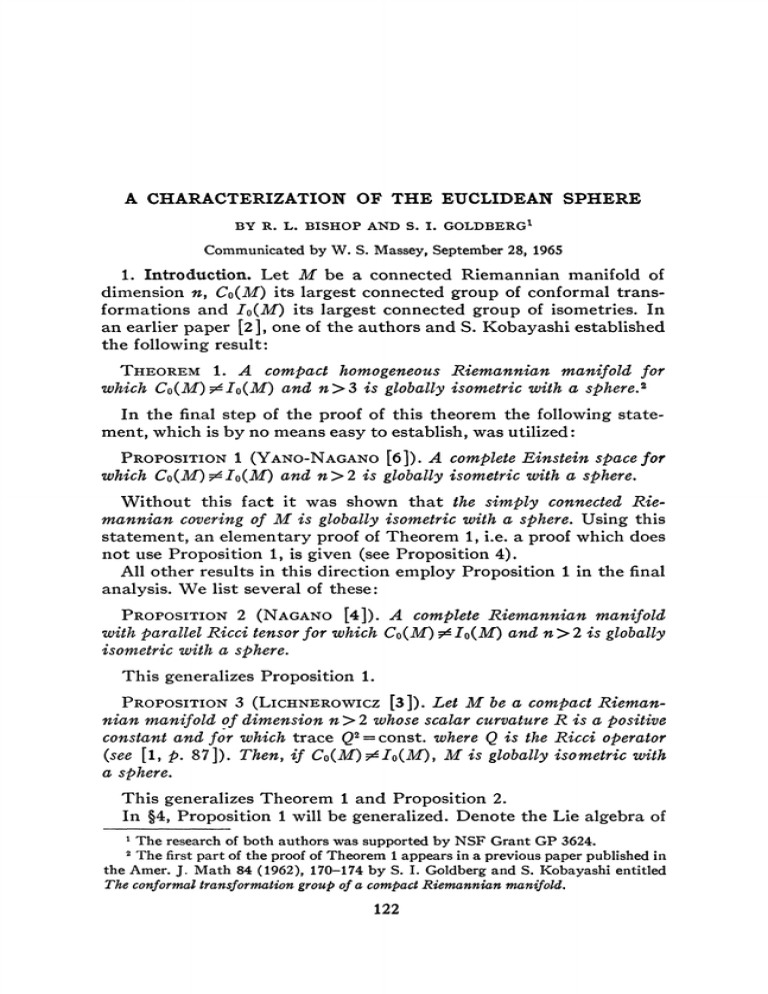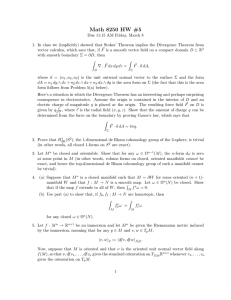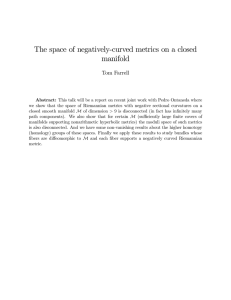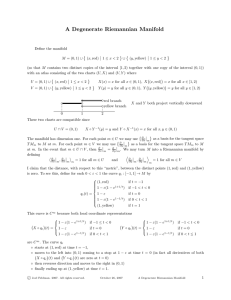A CHARACTERIZATION OF THE EUCLIDEAN
advertisement

A CHARACTERIZATION OF THE EUCLIDEAN SPHERE BY R. L. BISHOP AND S. I. GOLDBERG1 Communicated by W. S. Massey, September 28, 1965 1. Introduction. Let M be a connected Riemannian manifold of dimension n, Co(M) its largest connected group of conformai transformations and Io(M) its largest connected group of isometries. In an earlier paper [2], one of the authors and S. Kobayashi established the following result: T H E O R E M 1. A compact homogeneous Riemannian manifold for which CO(M)T^IO(M) and n>3 is globally isometric with a sphere.2 In the final step of the proof of this theorem the following statement, which is by no means easy to establish, was utilized: PROPOSITION 1 (YANO-NAGANO [6]). A complete Einstein space for which Co(M)^Io(M) and n>2 is globally isometric with a sphere. Without this fact it was shown t h a t the simply connected Riemannian covering of M is globally isometric with a sphere. Using this statement, an elementary proof of Theorem 1, i.e. a proof which does not use Proposition 1, is given (see Proposition 4). All other results in this direction employ Proposition 1 in the final analysis. We list several of these : PROPOSITION 2 (NAGANO [4]). A complete Riemannian manifold with parallel Ricci tensor f or which Co(M)9£Io(M) and n>2is globally isometric with a sphere. This generalizes Proposition 1. PROPOSITION 3 (LICHNEROWICZ [3]). Let M be a compact Riemannian manifold of dimension n>2 whose scalar curvature R is a positive constant and for which trace Q2 = const, where Q is the Ricci operator (see [l, p. 87]). Then, if CO(M)T*IO(M), M is globally isometric with a sphere. This generalizes Theorem 1 and Proposition 2. In §4, Proposition 1 will be generalized. Denote the Lie algebra of 1 The research of both authors was supported by NSF Grant GP 3624. The first part of the proof of Theorem 1 appears in a previous paper published in the Amer. J. Math 84 (1962), 170-174 by S. I. Goldberg and S. Kobayashi entitled The conformai transformation group of a compact Riemannian manifold. 2 122 A CHARACTERIZATION OF THE EUCLIDEAN SPHERE 123 Co(-M) by Co(M). Let XECo(M) and £ be the covariant form of X defined by duality by the Riemannian metric ( , ) of M:%=(X, •). Let CS(M)=[Z\£=(Xr), XECo(M)} and denote by d and Ô the differential and codifferential operators of de Rham and Hodge. Then [cf. M. Obata and K. Yano, C. R. Acad. Sci. Paris 260 (1965), 26982700]. THEOREM 2. Let M be a compact Riemannian manifold of dimension n>3 for which i? = const. and Co(M)^Io(M). If dôC$(M) is an invariant subspace of Q, then M is globally isometric with a sphere. This theoremal most completely answers the question raised in [2], namely, Is a compact manifold of dimension n>2 with constant (positive) scalar curvature f or which Co(M)7éIo(M) isometric with a sphere? Observe that Proposition 1 is an easy consequence of Theorem 2. 2. Isometries and conformai fields. If T is an isometry of the unit sphere Sn in £ w+1 , then T may be viewed as an orthogonal linear transformation of En+1 restricted to Sn. It is clear that any such isometry will map Killing fields into Killing fields and constant conformai fields (d(j> = (X, • )) into constant conformai fields. Thus if a conformal field is invariant under T so are its constant and Killing parts. It follows that if T leaves a non-Killing conformai field invariant then it has a fixed point, namely iV/||iV|| <~Sn, where N is a constant field in E w+1 and N- (N, P)P (P<ESn) is the constant part of V. 3. Conformai fields on a manifold of positive constant curvature. If Mis a compact Riemannian manifold with constant positive curvature then the nature of the conformai group of M does not change if we normalized the curvature so that it is 1. Thus, Sn is the simply connected covering Riemannian manifold of M. If M has a non-Killing conformai vector field V then this vector field may be lifted to a non-Killing conformai vector field V on Sn. Moreover, V is invariant by the deck transformations of the covering space Sn—>M. But only the identity deck transformation can have a fixed point, and since a deck transformation is an isometry we have from §2 that there are no deck transformations except the identity. This proves the following special case of Proposition 1 : PROPOSITION 4. If a compact Riemannian manifold of positive constant curvature admits a non-Killing conformai vector field then it is globally isometric with a sphere. Since the above argument clearly works for n = 2, we have 124 R. L. BISHOP AND S. I. GOLDBERG COROLLARY. The real projective plane does not admit a conformai vector field. non-Killing 4. Conformai fields on manifolds of constant scalar curvature. We sketch the proof of Theorem 2. Let £ = d0 be an element of C%(M). Then, Qdo% = doQi;. Conversely, suppose d8C$(M) is an invariant subspace of Q. Then, there exists a £ £ C * ( M ) such t h a t dô£ is an eigenvector of Q, t h a t is Qd8%**(R/n)dbl;(EC$(M). Moreover, since A*É«(jR/(n-l))«É (see [l, p . 264]), <fô£ = - ? + < F , •) n —1 where F is a Killing field. T h a t this can only hold if M has constant curvature is a consequence of the following: LEMMA. Let M be a compact Riemannian manifold on which there is a nonconstant f unction <j>: M-+R whose gradient % = d4><EC$(M). Then, there are no nonzero tensors of the type (r, s), 0<2(s—r)Sn invariant under X where £ == (X, • ). The proof of this lemma is intended for a subsequent paper. Setting T(A, B) = R(A, B ) - - (A, B), n where R is the Ricci tensor, it can be shown t h a t 0(£)r = O. Since the Weyl conformai curvature tensor is invariant under X, we see by the lemma t h a t M is conformally flat. However, since 0(£)T vanishes, a further application of the lemma gives r = 0, t h a t is M is an Einstein space. But a conformally flat Einstein space has constant curvature, and so by Proposition 4, M is globally isometric with a sphere. This proves Theorem 2 and generalizes Proposition 1. REFERENCES 1. S. I. Goldberg, Curvature and homology, Academic Press, New York, 1962. 2. S. I. Goldberg and S, Kobayashi, The conformai transformation group of a compact homogeneous Riemannian manifold. Bull. Amer. Math. Soc. 68 (1962), 378-381. 3. A. Lichnerowicz, Sur les transformations conformes d'une variété riemannienne compacte, C. R. Acad. Sci. Paris 259 (1964), 697-700. 4. T. Nagano, The conformai transformations on a space with parallel Ricci tensor, J. Math. Soc. Japan 11 (1959), 10-14. 5. S. Sternberg, Lectures on differential geometry, Prentice-Hall, Englewood Cliffs, N. J., 1964. 6. K. Yano and T. Nagano, Einstein spaces admitting a one-parameter group of conformai transformations, Ann. of Math. 69 (1959), 451-461. UNIVERSITY OF ILLINOIS



